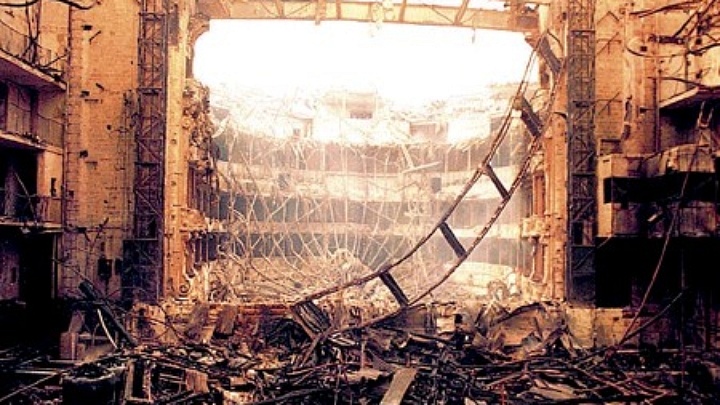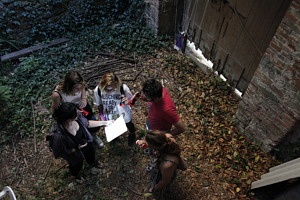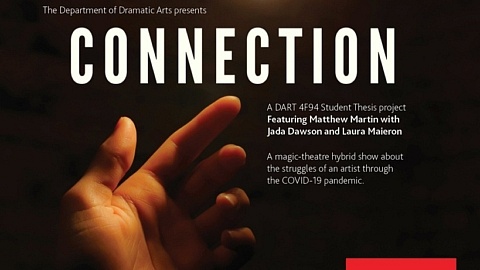“The magic of theatre” – a common descriptor of productions and a personal favourite explanation as to why I love the arts. Theatre has an ability to...
DopoLavoro Teatrale’s Inferno: Building the Fire
By Leah Eichler
Hello DARTcritics readers! Welcome to the first in a series of articles written by myself and my colleague Kristina Ojaperv, about our work following the making of Inferno, a new production by DopoLavoro Teatrale (henceforth DLT). Throughout the coming weeks, we will dive into various areas of interest: the conversations that happen before creation, the work that goes into the creation itself, and the outcome of said work. What we are doing is called embedded criticism, which is the practice of writing about theatre from an internal perspective; instead of viewing a show and reporting back on it, Kristina and I will be viewing DLT’s work from early conception, into the creation process, to the finished performance. The two of us will be working closely with DLT’s artistic director, Daniele Bartolini — in fact, in a state of privileged proximity to the entire creation of Inferno — to provide readers with two distinct perspectives on the work. Whereas I will be writing from the outside as a viewer, Kristina will be writing from the inside, as she is directly involved in the creation of the work (in ways she’ll explain in the next post). We note from the outset that while the show is still very much in development, there may be a spoiler or two here, so please read with this in mind.
Without further ado, let’s jump in!
- What Led Here
On the website for St. Catharines’ In the Soil Arts Festival, where this first iteration of Inferno will be presented, the production is described as “a new audience specific format that reflects on the roots of theatre, in which audiences are challenged to visit a contemporary urban hell.”
“What could that possibly mean?”,I wondered to myself. As I looked on DLT’s website, a few ideas of what this show might look like began to take place in my head, informed by the company’s previous work – most notably, The Ugly Mess That Happened in St. Catharines, an immersive theatre piece that led individual audience members on a three-day adventure through different areas in downtown St. Catharines, trying to piece together the story of a missing girl. Past DARTcritics writers reviewed the show in 2016, providing a possible insight into what Inferno might be like. In That Ugly Mess…, audience members played an active role in the story – it would only progress if they actively spoke to the actors, asked questions, and followed the advice they were given.
This gave me a few preconceived notions, which I checked in an initial sit-down meeting with Daniele and my editor Karen Fricker on May 24. At this point, I was buzzing with excitement at the idea of immersive theatre, a personal favourite topic of mine. When discussing the ideas and goals behind Inferno, Daniele kept repeating that he is always brought back to the age-old question: what is the point of theatre? We theatre practitioners have been mulling over this for centuries, each taking a crack at the answer in our own way. For DLT, the key seems to lie in creating a participatory experience that encompasses all of the audience’s senses. The concept of site-specific theatre is familiar – and one might have labelled DLT’s work under that category – but what Daniele explained is that his company wants to create audience-specific theatre.
In That Ugly Mess…, the events audiences were led through took place outdoors. In Inferno, Daniele notes, the goal is to reconnect to the roots of theatre after having been out on the streets. Another point he underlines is that Inferno as presented in St. Catharines will not be a finished product – it is an experiment. Part of this experiment is the combination of classical sit-in-an-audience-and-watch theatre with more avant-garde be-an-active-participant-in-the-show theatre. While Daniele anticipates that in its ongoing life the show will play to a larger group, in St. Catharines, number of audience members will be limited to 12. The goal of this is both to increase the sense of community and the participation of the audience. Daniele continually circles back to a second question he is exploring through this work: how do we make theatre available to more people?
- The Idea So Far
As our conversation continues, we move onto the more specific topic of DLT’s intentions for the St. Catharines performances. The main intent, as I gather from our exchange, is to encourage the audience’s authorship. Briefly, and beginning as a joke, Karen connects that idea to the reception of the ending of Game of Thrones – how the series’ fans held such a sense of entitlement around the outcome of the story that, when the last season wrapped up and was overall received poorly, they began to create petitions to have it redone.
Yet despite starting as a joke, there seems to be a lot of truth to this idea. It’s a version of what Daniele agrees he is aiming for – for the audience to take chargeof the story, to own it and feel as though it is theirs. In this performance, DLT wants to make actors forget that they are actors, and audience members forget that they are audience members.
Conceptually, Inferno is inspired by classical texts. There is the name, Inferno, which is a nod to the work by Dante. Daniele also makes clear that the piece is inspired by the idea of an odyssey: not necessarily Homer’s The Odyssey itself, but the connotations of the word, the vastness, the sheer awesomeness of an odyssey. It will be particularly interesting to see how these ideas clarify and solidify as the work continues. From what I understand, this performance will not be plot-driven, though it seems as though it will have elements of narration. The drive is towards creating an experience for the audience to partake in.
“What I’m interested in is that the audience should follow a character [into the theatre],” Daniele explains. “We enter the theatre so many times, right? But I don’t know if an audience has had the experience of entering the theatre already being in the piece… I’m interested in having the audience sit in a pretty usual audience setting, having [a classical play] that happens on stage. And then I’m interested in this thing breaking down, having a real interruption, which is the actual… real beginning of everything.”
From this point, Daniele described a few things that might take place after the interruption – all focused on drawing the audience into becoming active participants. I will not share any specifics here, so as to not spoil the experience for readers who may participate in the performance. In the age of the internet, the world needs a little more suspense.
- Last words…
DLT’s Inferno is a work in progress. The audience members that see it at In the Soil will effectively be rendered beta testers for this version of the experiment, helping DLT see what works and what doesn’t. Ultimately, the show will open in its full form in 2021, with up to 48 audience members per performance. For those who participate in St Catharines, it’s a chance to be part of the work of a company that aspires to make the audience as necessary to the theatre experience as the actorsthemselves.
When I first walked into my meeting with Daniele, I had preconceptions that Inferno would be a plot-driven story where audience members would be led through St. Catharines. Instead, what I found was a swirling mass of ideas, combining audience-specific theatre with classical texts; taking multiple forms of theatrical experiences, from walking around to sitting in a theatre, and mixing them to see what happens. Going forward, I am particularly interested in seeing how Homer and Dante’s texts play into Inferno, and what shape the audience participation will take in the finalized show. The next things you read about the show will be from Kristina, as she introduces her engagement with the production and how it’s grown since I first encountered it.
Inferno runs June 8th and 9th at the 2019 In the Soil Arts Festival in St. Catharines. Tickets and further information: https://inthesoil.on.ca.
Related Posts
For nearly two years, theatre lovers have felt entrapped in their own little purgatories. Artists have been unable to perform on stages, and audiences been...
It’s been a few weeks since the final performance of Brock University Department of Dramatic Arts’ Fall Mainstage, Scenes from an Execution. Closing off their...
For nearly two years, theatre lovers have felt entrapped in their own little purgatories. Artists have been unable to perform on stages, and audiences been...
It’s been a few weeks since the final performance of Brock University Department of Dramatic Arts’ Fall Mainstage, Scenes from an Execution. Closing off their...
Leave a Reply (Cancel Reply)
Twitter Feed
Blogroll
DARTcritics.com is partially funded by the Marilyn I. Walker School of Fine and Performing Arts, in support of student learning; experiential education; student professionalization; public engagement with the teaching, learning and production activities of the Department of Dramatic Arts; new ways of thinking; and the nurturing of links with our communities.







